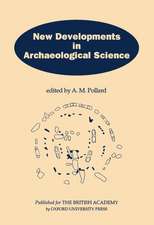The Archaeologist's Manual for Conservation: A Guide to Non-Toxic, Minimal Intervention Artifact Stabilization
Autor Bradley A. Rodgersen Limba Engleză Paperback – 21 iul 2004
| Toate formatele și edițiile | Preț | Express |
|---|---|---|
| Paperback (1) | 435.47 lei 6-8 săpt. | |
| Springer Us – 21 iul 2004 | 435.47 lei 6-8 săpt. | |
| Hardback (1) | 425.20 lei 6-8 săpt. | |
| Springer Us – 2 iul 2004 | 425.20 lei 6-8 săpt. |
Preț: 435.47 lei
Nou
Puncte Express: 653
Preț estimativ în valută:
83.34€ • 86.68$ • 68.80£
83.34€ • 86.68$ • 68.80£
Carte tipărită la comandă
Livrare economică 15-29 aprilie
Preluare comenzi: 021 569.72.76
Specificații
ISBN-13: 9780306484674
ISBN-10: 0306484676
Pagini: 214
Ilustrații: XVII, 214 p.
Dimensiuni: 155 x 235 x 14 mm
Greutate: 0.75 kg
Ediția:2004
Editura: Springer Us
Colecția Springer
Locul publicării:New York, NY, United States
ISBN-10: 0306484676
Pagini: 214
Ilustrații: XVII, 214 p.
Dimensiuni: 155 x 235 x 14 mm
Greutate: 0.75 kg
Ediția:2004
Editura: Springer Us
Colecția Springer
Locul publicării:New York, NY, United States
Public țintă
ResearchCuprins
The Minimal Intervention Laboratory.- Archaeological Wood.- Archaeological Iron (Fe).- Archaeological Copper (Cu) and Copper Alloys.- Miscellaneous Archaeological Metals.- Archaeological Ceramic, Glass, and Stone.- Organics Other than Wood.- Archaeological Composites.
Recenzii
From the reviews:
"This book attempts to bring conservation back into the field of archaeology by acting as a narrative or a resource book … . Within the book are several types of figures, including illustrations, photographs, flowcharts, computer drawings, graphs and tables. … it is a very useful reference and can be used as an introductory text for all archaeologists … . The goals of the book have been achieved and it would make an excellent and useful addition to any archaeologist’s library." (Brandy Lockhart, Australian Archaeology, Issue 62, June, 2006)
"This book attempts to bring conservation back into the field of archaeology by acting as a narrative or a resource book … . Within the book are several types of figures, including illustrations, photographs, flowcharts, computer drawings, graphs and tables. … it is a very useful reference and can be used as an introductory text for all archaeologists … . The goals of the book have been achieved and it would make an excellent and useful addition to any archaeologist’s library." (Brandy Lockhart, Australian Archaeology, Issue 62, June, 2006)
Notă biografică
'This manual is designed to take the mysticism out of archaeological artifact conservation and act as both reference and guide. It is intended as a tool to assist archaeologists in stabilizing a majority of the artifacts they excavate, or those already in storage. These stabilized archaeological collections will be preserved into the future, permitting reexamination and multiple interpretations of the data as our knowledge base grows through time. In addition, conservation will permit improved in-depth primary artifact interpretation, as fully conserved artifacts reveal fabrication, wear patterns, and detail impossible to detect in non-conserved artifacts. Conservation, therefore, is a critical tool within archaeology, a tool that becomes less meaningful if it is isolated, or seen as merely a technical skill that can be farmed out to the "hard sciences." The Archaeologist's Manual for Conservation is intended as a counterpoint to the popular specialization trend. My goal in offering this manual is to put artifacts back in the hands of archaeologists or material culture specialists who can best decipher them, opening avenues of artifact or material culture interpretation that are disappearing as artifacts either decay in storage or are sent away to the "conservation professionals".' - from the Introduction.
This book is the culmination of over 10 years of work and the merging, expansion, and improvement of 2 previous works: Conservator's Cookbook and Conservation of Water Soaked Materials Bibliography. Each chapter covers a particular substance:
wood, iron, copper, glass, ceramic, organic artifacts, textiles, and leather, composite artifacts. Chapters begin with a visual flow chart, walking the archaeologist through a step-by-step stabilization process, backed in the text by theoretical discussion and description. Practical methodology follows theory in each chapter giving the archaeologist a more detailed description of preserving material remains. Chapters are backed and serviced by the most comprehensive bibliographic reference available today.
The Archaeologist's Manual for Conservation was developed through extensive documentary research, laboratory trial and error, and the feedback of both underwater and terrestrial archaeologists. It will become an indispensable reference for all archaeologists, laboratory technicians, archaeology students, curators, and conservators concerned with simple, proven, non-toxic, artifact conservation procedures.
This book is the culmination of over 10 years of work and the merging, expansion, and improvement of 2 previous works: Conservator's Cookbook and Conservation of Water Soaked Materials Bibliography. Each chapter covers a particular substance:
wood, iron, copper, glass, ceramic, organic artifacts, textiles, and leather, composite artifacts. Chapters begin with a visual flow chart, walking the archaeologist through a step-by-step stabilization process, backed in the text by theoretical discussion and description. Practical methodology follows theory in each chapter giving the archaeologist a more detailed description of preserving material remains. Chapters are backed and serviced by the most comprehensive bibliographic reference available today.
The Archaeologist's Manual for Conservation was developed through extensive documentary research, laboratory trial and error, and the feedback of both underwater and terrestrial archaeologists. It will become an indispensable reference for all archaeologists, laboratory technicians, archaeology students, curators, and conservators concerned with simple, proven, non-toxic, artifact conservation procedures.













